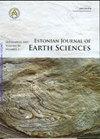The Late Ordovician extinction conundrum
IF 0.8
4区 地球科学
Q4 GEOSCIENCES, MULTIDISCIPLINARY
引用次数: 0
Abstract
The Late Ordovician mass extinction (LOME) has long been known for its association with the Hirnantian glaciations. Two extinction pulses seem to reflect global cooling and warming, respectively. The effects climate change had on Ordovician life are well documented through palaeontological evidence, several geochemical proxies and further simulated in modelling scenarios. Preceding the Hirnantian extinction interval was a phase of prolific faunal migrations in notably the later parts of the Katian. Well-documented evidence shows that low-latitude faunas dispersed to high latitudes, and taxa that had previously been endemic to particularly Baltica and South China, suddenly began to appear in Laurentia. These events, referred to as the Boda warming event and the Richmondian invasion, have been suggested to reflect a biotic response to warmer climate indicating that the onset of the subsequent Hirnantian icehouse marked a considerable environmental shift from the latest Katian warming phase. Whereas a lot of focus has been on untangling the selective effects of the two Hirnantian extinction pulses on different clades, less focus has been on what led to the transition from the Middle Ordovician biodiversity rise to the dispersal phase seen during the Katian. It appears that most clades did not – during any point of time in the Ordovician – surpass the richness levels they had achieved by the earliest Katian. Rather, a plateau was established when all metazoan clades are compiled together. This could suggest that extinction rates began to increase relative to originations. Either a threshold was reached by the early Katian prohibiting ecosystems to expand, or an extinction pulse occurred that decimated overall biodiversity accumulation. Two lines of evidence suggest the latter to be the case. Firstly, several new clades became hugely diverse by the Katian. These include bryozoans, crinoids, rugose and tabulate corals, as well as molluscs such as bivalves and gastropods, and show that obviously increased ecosystem complexity with, for instance, more epifauna and tiering occurred. Secondly, large richness datasets compiled from all奥陶纪晚期灭绝之谜
晚奥陶世大灭绝(LOME)一直被认为与希尔南梯冰期有关。两个灭绝脉冲似乎分别反映了全球变冷和变暖。气候变化对奥陶纪生命的影响已通过古生物学证据、几种地球化学指标和模拟情景得到了很好的证明。在Hirnantian灭绝间隔之前,是一个多产的动物迁徙阶段,特别是在Katian的后期。有充分证据表明,低纬度地区的动物群向高纬度地区分散,以前在波罗的海和华南地区特有的分类群突然开始出现在劳伦西亚。这些事件被称为Boda变暖事件和Richmondian入侵,它们被认为反映了生物对气候变暖的反应,表明随后的Hirnantian冰库的出现标志着从最新的Katian变暖阶段的相当大的环境转变。尽管很多人关注的是解开两个Hirnantian灭绝脉冲对不同进化支的选择性影响,但很少有人关注是什么导致了中奥陶世生物多样性上升到Katian时期的分散阶段的转变。在奥陶纪的任何时间点上,大多数进化枝似乎都没有超过它们在卡天纪早期所达到的丰富程度。更确切地说,当所有后生动物的进化枝汇集在一起时,一个平台就建立起来了。这可能表明,相对于起源,灭绝率开始增加。要么是卡提亚早期达到了一个阈值,禁止生态系统扩张,要么是发生了灭绝脉冲,破坏了整体生物多样性的积累。有两种证据表明后者是正确的。首先,几个新的进化支在卡蒂亚演化过程中变得非常多样化。这些物种包括苔藓虫、海百合、袋珊瑚和表珊瑚,以及双壳类和腹足类等软体动物,并表明生态系统的复杂性明显增加,例如,更多的表动物和分层发生了。其次,大型丰富度数据集从所有
本文章由计算机程序翻译,如有差异,请以英文原文为准。
求助全文
约1分钟内获得全文
求助全文
来源期刊

Estonian Journal of Earth Sciences
地学-地球科学综合
CiteScore
1.50
自引率
9.10%
发文量
11
审稿时长
>12 weeks
期刊介绍:
The Estonian Journal of Earth Sciences is an international scientific open access journal published by the Estonian Academy of Sciences in collaboration with the Tallinn University of Technology, the University of Tartu, the Estonian University of Life Sciences and the Talllinn University.
The journal publishes primary research and review papers in the English language. All articles are provided with short Estonian summaries.
All papers to be published in the journal are peer reviewed internationally.
The journal is open for publications in all fields of Earth sciences, including besides different geological sensu lato disciplines, also geography and oceanography having certain connection with our part of the world, North Europe and the Baltic area in particular.
 求助内容:
求助内容: 应助结果提醒方式:
应助结果提醒方式:


